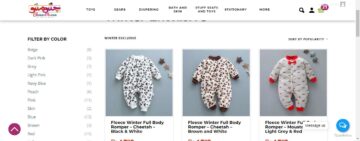
Younger children are more vulnerable to the cold since their bodies quickly lose heat due to their smaller size. Younger children are also less likely to recognize when they are becoming cold, so it is up to us parents to keep them warm and be aware of when it is time to go inside.
Additionally, clothing infants and kids for the cold takes skill. Our winter wardrobe advice will ensure that they are comfortable whether they are accompanying you to the shop, taking a stroller ride, or heading to the park.
- Give your youngster a say in choosing their winter attire.
Give your child a chance to choose what clothing he can wear to bed, after school, and on weekends even if winter school uniforms are a given. Go shopping with him and present him with various (warm) alternatives that are colourful, enjoyable, and cool.
Even while your child’s clothes selections might not always match your personal sense of style, if they enjoy them and wear them, you can consider it a parenting success.
- Still, bring warm clothing
Packing a warm coat in her school bag when you know she won’t use it may seem like a complete waste of effort. But her peers’ power over her decisions may surprise you, as it did me. If everyone else is wearing a coat, she will too!
They have your back! Teachers and caregivers will also attempt to emphasize the value of wearing warmly.
- Let them experience the repercussions.
The harsh love technique is another option. Allow nature to run its course if all else fails. Maybe he’s the sort of kid who has to learn from mistakes, and getting a cold will give you a chance to tell him, “I told you so.”
He would then get why you keep harping on about dressing in layers.
- Layering is essential for winter
The American Academy of Pediatrics suggests the following general guideline for winter clothing: Put one extra layer of clothes on newborns and kids than an adult would in the same circumstances. Why? Air pockets between layers of clothes really aid in retaining heat. By layering, children can avoid deciding between being too hot or too cold while, for example, they are in a moving vehicle.
- But Not Too Many Layers…
See the preceding generalization. Over-layering your youngster in outerwear may make them feel colder. This is because wearing too many layers might make your child sweat, making their clothing wet and allowing the cold and wind to lower their body temperature.
- Learn Layering 101
You should know the three fundamental layers and the best materials for each. If you’re not an alpine climber, it could seem intimidating, but it’s not as hard as it appears. The essential information is as follows:
The layer immediately adjacent to your child’s skin, or base layers
- Its function is to wick moisture.
- Materials to consider include wool and synthetic materials like polyester.
- Snug Middle Layers provide the ideal fit.
(Surpasses Base Layer)
- It acts as insulation.
- Look for thread, down, or fleece, among other materials.
- The perfect fit is snug without restricting movement.
Outside Layer
- It shields your kid from the wind, snow, and rain.
- Resources to seek: If your child is physically active, a waterproof jacket or shell is essential. Outerwear that is also breathable (like those made of Gore-Tex) is also necessary.
- The ideal fit: makes movement simple and provides lots of space for layering
- Nix the Cotton
You already know that cotton clothing, including cotton shirts and pants, can wick away moisture from the air, snow, and rain. And chilly weather combined with damp cotton makes kids very cold. It is preferable to avoid cotton entirely when the weather is chilly.
Eliminating the cotton should not be an issue with so many athletic and adorably attractive fleece choices available now.
- Faces, Fingers, and Toes Need Extra Care
Your child’s head, face, ears, hands, and feet are most vulnerable to frostbite, according to kidshealth.org. Like getting burnt in the winter, frostbite affects the skin and typically results in numbness. Keep an eye on children’s extremities since their skin is particularly susceptible to the cold. On chilly days, wearing heavy, non-cotton socks, waterproof boots, gloves, a scarf, and a cap is essential for keeping everyone warm. Earmuffs and facemasks provide additional protection in freezing weather (we’re looking at you, Buffalo!).
- Verify that clothing (still) fits
While cramming those tootsies into last year’s booties would be appealing, feet need room to move. Too-tight shoes and coats might restrict blood flow and cause cold limbs.
- Include a Dry Bag.
As you undoubtedly already know, keeping extra clothing for kids is always a good idea. Still, in the winter, the additional dress is crucial. One joyful splash in a puddle or one wet (or misplaced) mitten might ruin your day of pleasure and put your kids at risk for frostbite. Prepare an emergency kit for chilly weather that includes additional gloves, socks, trousers, and shirts.
















